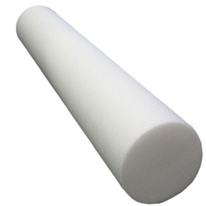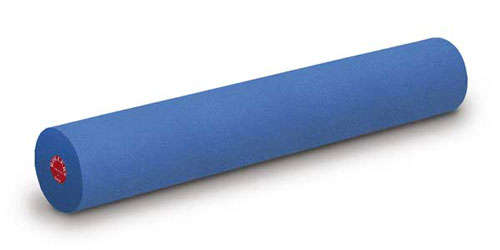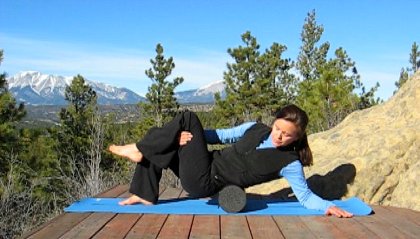 Foam rolling is becoming a very popular technique within the health and fitness community. But what is it exactly, who uses it, and why?
Foam rolling is becoming a very popular technique within the health and fitness community. But what is it exactly, who uses it, and why?
Foam rolling is a self massage (also known as self myofascial release) technique. It uses a long cylindrical piece of foam in which muscles of the body are rolled over it several times to produce desirable effects. These include: improving blood flow, removing shortened localized areas of muscle tissue (trigger points), and lengthening of entire muscles. Lets explore how it lengthens muscle first.
Muscle lengthening is achieved through a process known as autogenic inhibition. Essentially, when a muscle is in a shortened state (from trauma, or a very hard workout for example) it can become “tight” and there are receptors in the muscle (muscle spindles) that maintain this state. If you are trying to stretch the muscle, the muscle spindles maintain the shortened state, or make the muscle even shorter. This is where foam rolling comes in.
even shorter. This is where foam rolling comes in.
Rolling a tender muscle over a foam roller before stretching causes the muscle spindles to become less active. It does this by stimulating another receptor known as a Golgi Tendon Organ, or GTO (which resides on the tendinous area of the same muscle). When the foam roller hits these receptors, the GTOs send a message to the muscle spindles to become less active. In effect, the foam roller allows the muscle to relax so that stretching can effectively lengthen the muscle.
Briefly touching on trigger points (I will leave further discussion of this for a manual therapist) foam rolling is also a method of reducing trigger points, or shortened and tender localized areas of muscle. Trigger points can occur from a myriad of causes. Some include overuse, heavy lifting, sustained contractions (from stress), trauma, and poor posture to name a few. Trigger points can have a characteristic tenderness when pressed upon. Sometimes, the trigger point will exhibit pain without having to place pressure on it at all. In either case, foam rolling can help alleviate these symptoms as well.
Who can use foam rolling?
Athletes, weekend warriors, individuals just starting a healthy lifestyle change, and people recovering from different types of musculoskeletal injuries. Foam rolling is great for people who wish to keep their muscles pain free, lengthened and relaxed.
Who shouldn’t use foam rolling?
In all fairness, there are situations where a person should not use this self myofascial release technique. These include: people with malignant tissues, osteoporosis, osteomylitis (bone infection), phelebitis (vein infections), cellulitis (soft tissue infection), acute rheumatoid arthritis, blood clots, goiter (enlarged thyroid), skin lesions, open wounds, healing fractures, advanced diabetes, and hematomas (1) If you are unsure, please visit your family physician before using a foam roller.
Where are common areas that people use foam rolling?
Foam rolling can be used on practically any muscle you can lie your bodyweight on. This includes the calves, front and rear thighs, glutes, and low, mid, and upper back muscles.
How often do you use the foam roller?
There are really no hard written rules for how much or how often the foam roller can be used. However, when introducing the foam roller, I believe a conservative approach is best. I think applying pressure to a muscle for 30 seconds to a minute will suffice initially. I also think that once a day, everyday, is a good start on the muscles that are in question. When your tolerance increases, trying the roller a couple times a day is a great idea. Eventually, the pain will decrease, and you can use the roller a little less often, or as needed.
Are there different types of foam rollers?
Yes there are. They come in different densities. White foam rollers are known as the softest. These are great for people that have very sensitive trigger points, or those people with low pain thresholds. But if you use it once a day everyday for a couple weeks, it wont take long before you will require a denser foam roller
Blue foam rollers are quite accessible here in St. John’s. They are certainly denser than white ones so be prepared when first using it. They all come in generally 3 foot lengths and are about 35-40 bucks each. They are worth the investment.
Some foam rollers can also have solid cores place through them to further improve the density beyond the blue ones.
That depends on the target muscle. There are many positions to assume, but lets take a look at the low back as an example: Sit down on the floor. Place the foam roller behind your butt. Then assume a side lying position with your left elbow and your left hip on the floor. Proceed to rest your low back on the foam roller until it contacts the lower left side of your back (see picture to the right). Begin to use your legs and left elbow to roll your lower left back muscles (spinal erectors) over the foam roller. First time users often find that it instantly created a noticeable level of discomfort. This is typical. Continue making slight (3-6 inch) upward and downward movements about the lower left back. Continue this for about 30 seconds or 20 passes. Then do the same method for the right side.
When should I use the foam roller? (before or after physical activity?)
Both are a great idea actually. Foam rolling prior to exercise decreases the likelihood of overactive muscle spindles (see explanation above) This means muscles with move more freely and more efficiently through their course of motion. Foam rolling afterwards will promote blood flow and waste removal (lactate).
Enjoy!
Michael McIsaac, BKIN, CEP, CSCS
References:
1. Harris RE, Clauw DJ. The use of complimentary medical therapies in the management of myofascial pain disorders. Curr Pain Headache Rep. 2002; 6 (5): 370-374.

